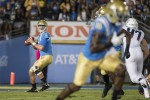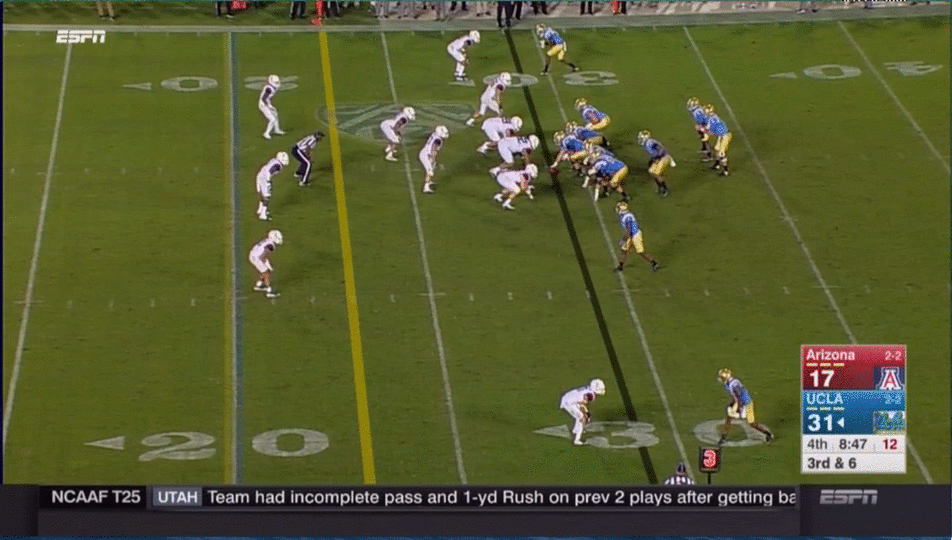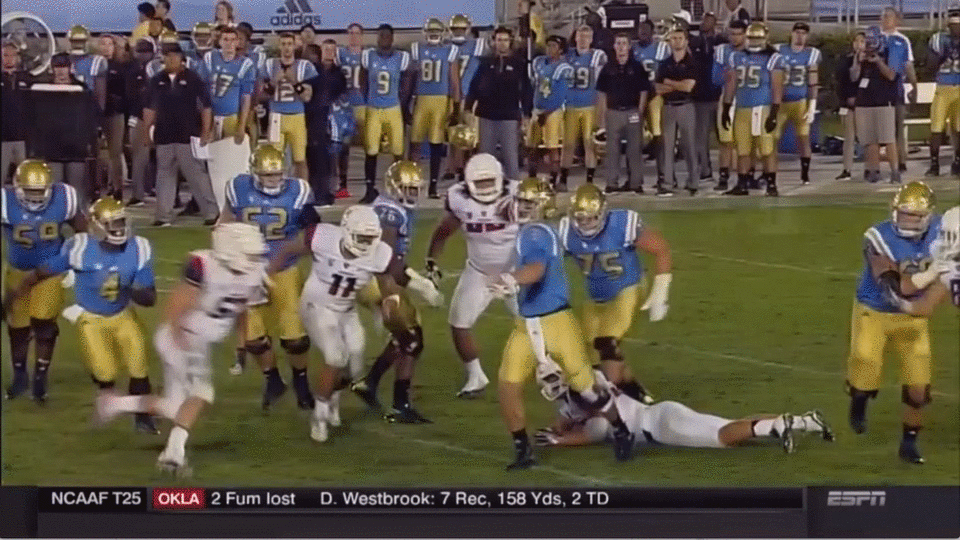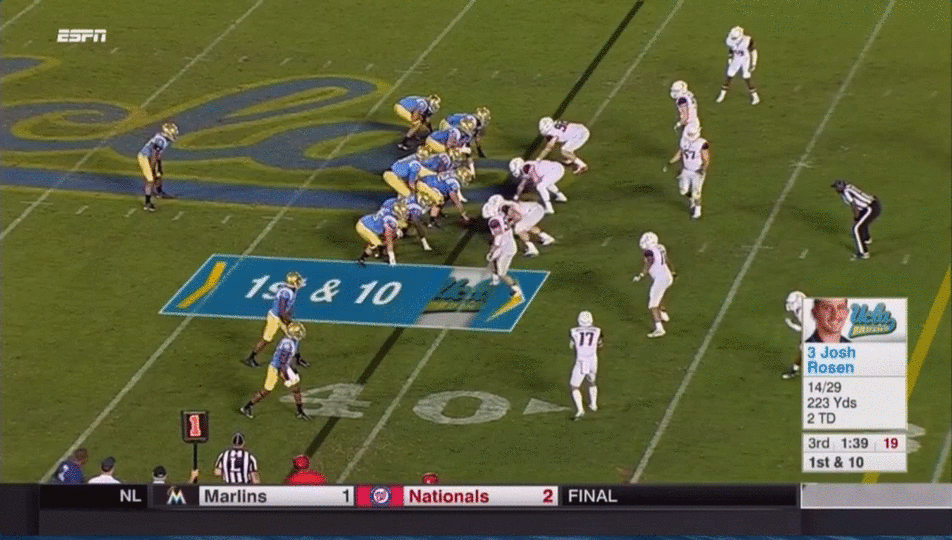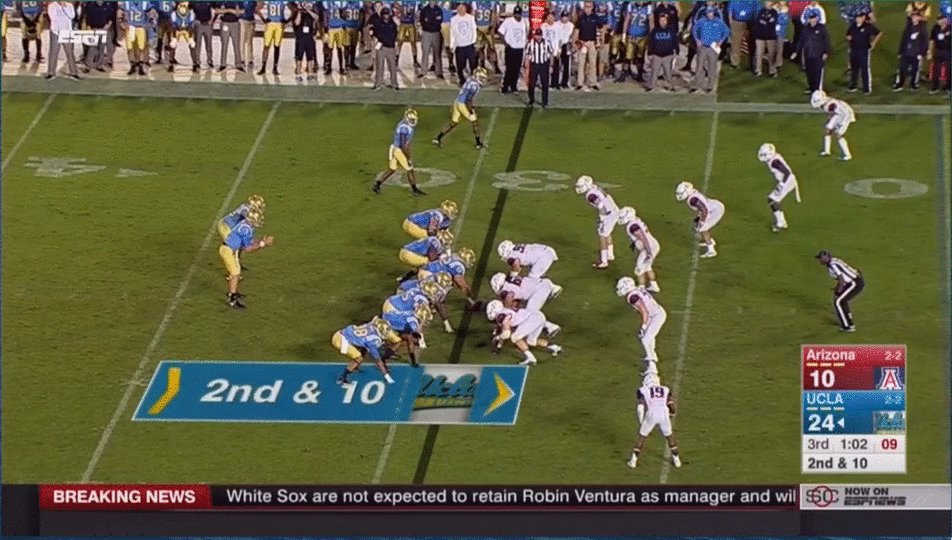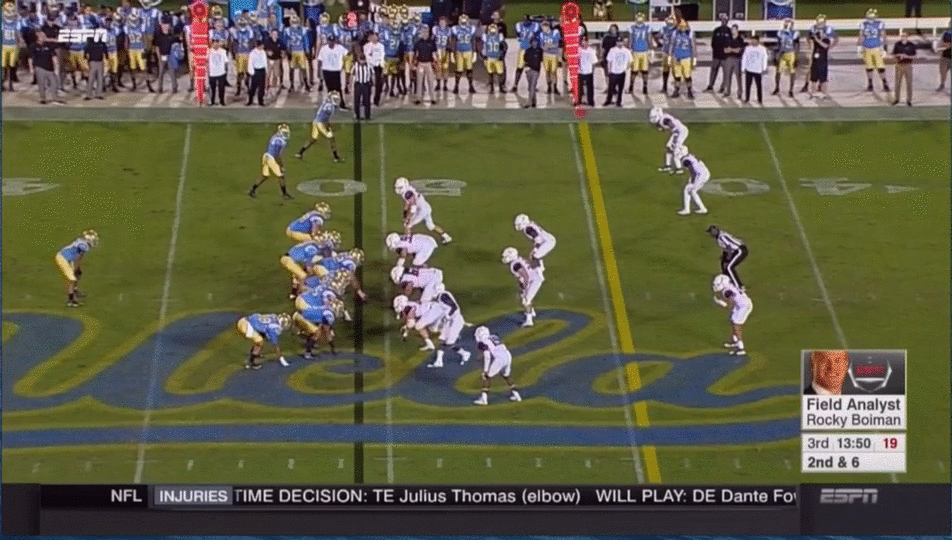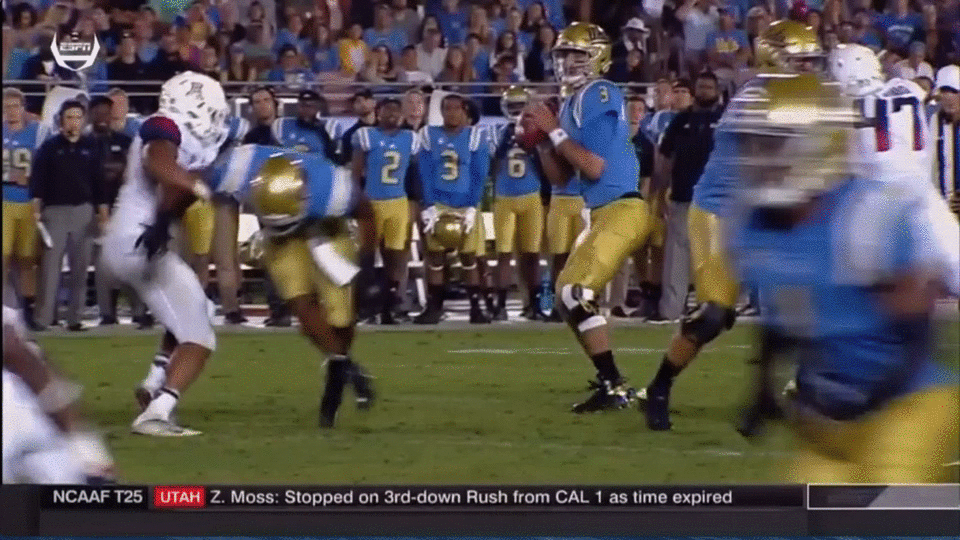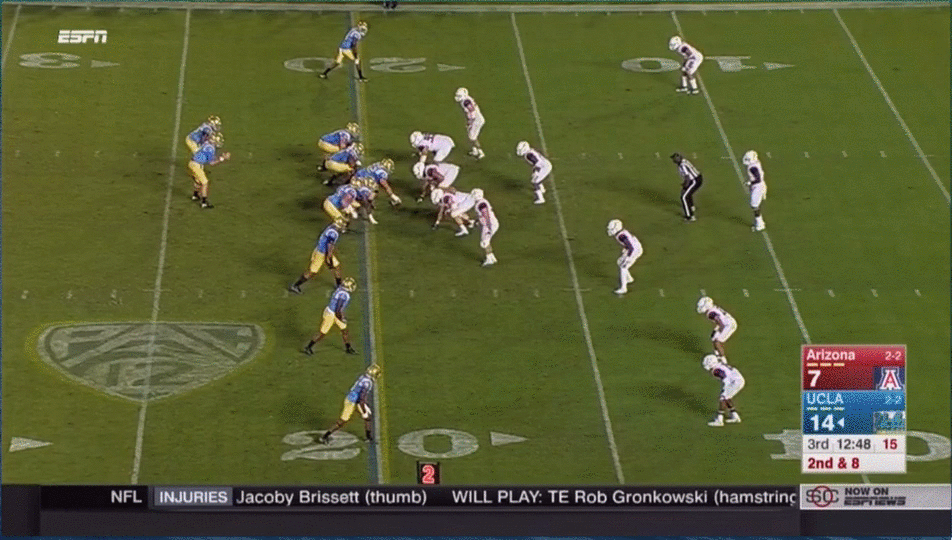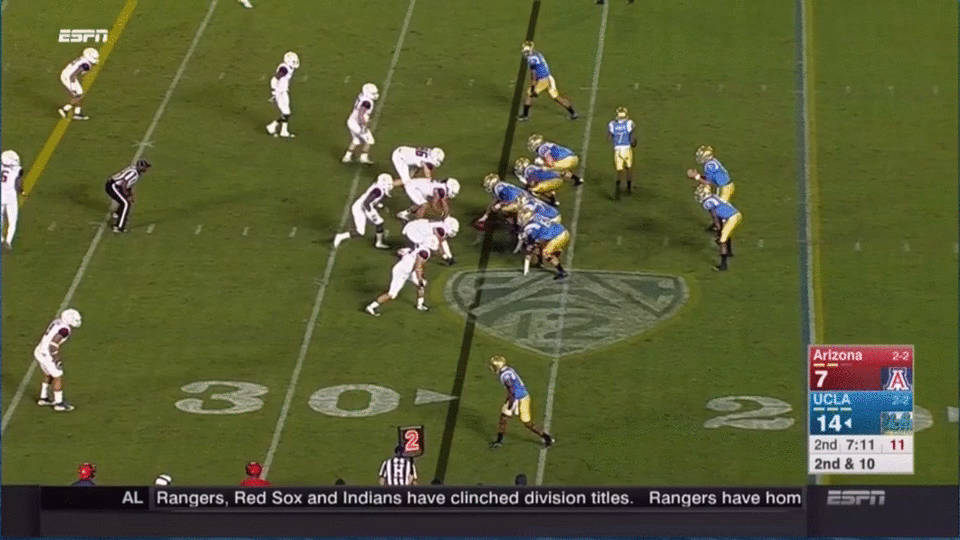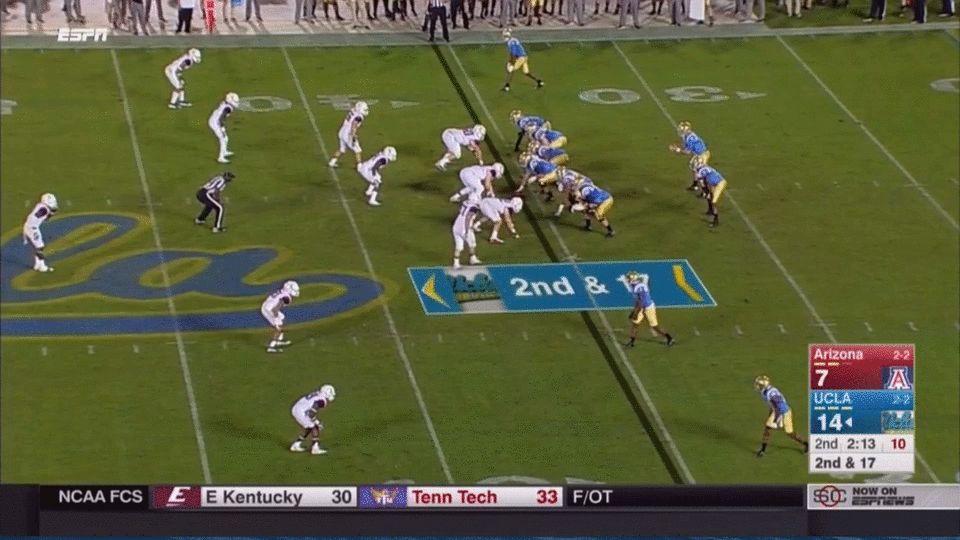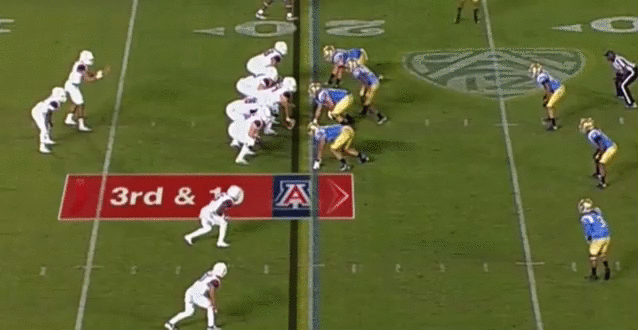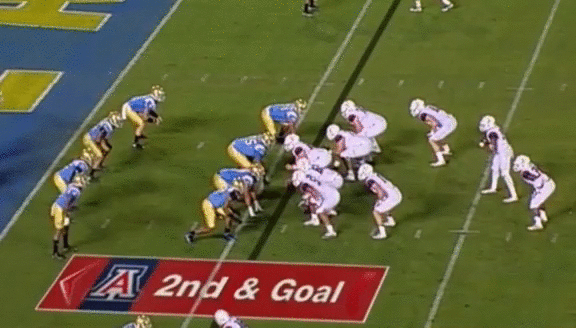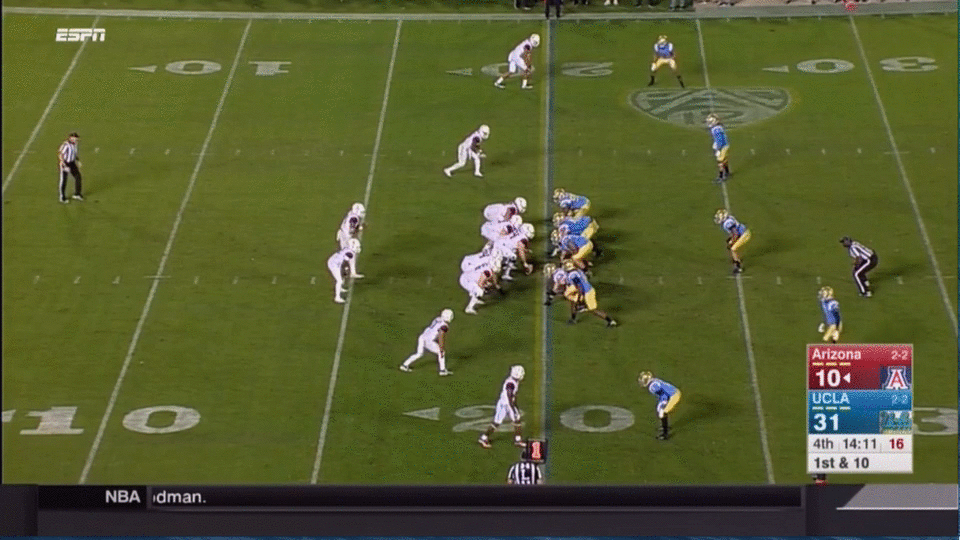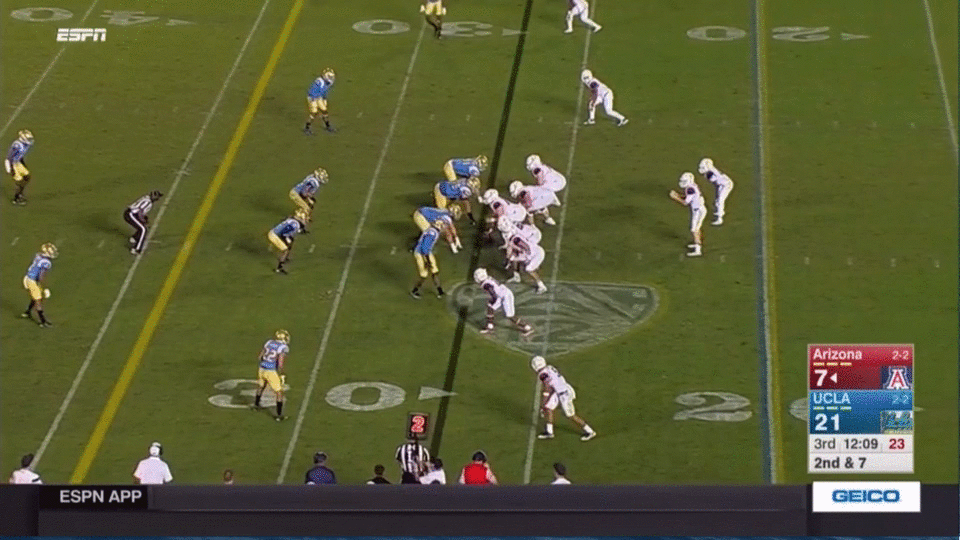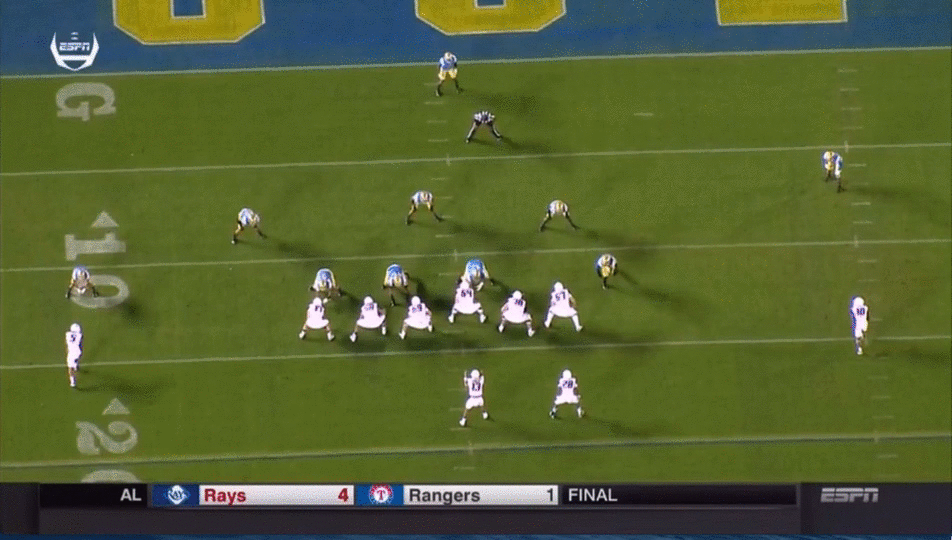Quarterbacks: B+
Three touchdowns, 350 yards. Those numbers would earn most quarterbacks a week full of praise, but for Josh Rosen, they’re greeted by the sentiment that he finally lived up to expectations.
Rosen thinks he’s the best quarterback in the country, and even if he isn’t, he’s certainly one of the best at evaluating his own performances. The sophomore said that after Saturday’s game he thought the second half was the best he’s played all year.
The stats back up his assessment. He completed 11 of his 13 attempts for 182 yards and a pair of scores in the second half. And his fourth-quarter touchdown to redshirt senior wide receiver Kenneth Walker might have been his best throw of the season.
He gets his ankles out from the grasp of one defender, twists his body and fires a perfectly placed ball to the corner right as another defender crushes him to the ground.
Rosen had a really poor second quarter, connecting on just two of his 14 passes as he faced constant pressure throughout the period. The Wildcats blitzed him relentlessly all night, sending extra rushers on 25 of his 37 pass attempts, per Pro Football Focus, and at times, they were getting home and giving Rosen serious problems.
Without being privy to the inner workings of the offense, it’s hard to know whether Rosen should be blamed for some of the failures in handling the blitz. Generally, though, a quarterback does have something to do with his blockers’ protection from a schematic standpoint, so I’ll dock Rosen a bit for his struggles in the first half identifying blitzes.
Rosen, however, was sometimes able to exploit blitzes by escaping the pocket and finding receivers on “scramble drills.” That’s what happened on this 62-yard touchdown to Walker.
Rosen only completed 44 percent of his passes when blitzed, but because of big plays, like that, he produced an average of 8.3 yards per attempt against the blitz.
Running backs: B
The Bruins really struggled to run the ball in the first half, generating just 26 yards on 14 carries. If you subtract the 14-yard sweep by redshirt senior wide receiver Ishmael Adams, UCLA had just 12 yards on 13 carries in the first half.
That’s bad.
It wasn’t entirely the running backs’ fault. Nate Starks was the featured tailback for the night, and the junior did his best to get yards even when his blockers let defenders into the backfield.
But Starks really didn’t break out until the second half, when he ripped off runs of 29 and 12 yards, both coming when he abandoned interior running lanes to bounce the play outside and take off running.
Another 7-yard run came the same way.
Overall, Starks earned himself more chances as the team’s featured back, showing that he had some big-play potential while also serving as a capable pass protector in the second half and demonstrating comfort as a route-runner when split outside.
Wide receivers and tight ends: B+
All year long, the talk around UCLA football has been that someone would need to emerge as a reliable go-to receiver.
Darren Andrews had shown signs of developing into that guy, and Saturday he seemed to take the next step. He made nine catches for 108 yards, setting career-highs in both categories and marking the 13th straight game in which he’s recorded multiple receptions.
None of his catches were spectacular, but the redshirt junior showed good hands throughout the night, reeling in the ball away from his body and bringing it into his body powerfully.
Walker also produced a strong outing, with four catches for 114 yards.
In Andrews and Walker, the Bruins may have themselves a nice duo to lead the receiving corps going forward. If Andrews is the reliable short and intermediate option, Walker is clearly the big-play guy for the Bruins. His 29-yard touchdown in the fourth quarter was his first score from under 57 yards.
Both of them are also impressive downfield blockers, as they showed on Starks’ 29-yard run.
The receivers as a whole looked pretty pedestrian – if not worse – in the first half, as their inability to separate and their struggles catching the ball reared their ugly heads in the second quarter especially. Heading into halftime, this third-down drop by redshirt junior Eldridge Massington seemed to define the evening.
But in the third quarter, the Bruins gave highly touted freshman wideout Theo Howard an opportunity, and the youngster energized the unit with a gorgeous 19-yard touchdown.
Coach Jim Mora said after the game that Howard will see more playing time in the future. If he can turn into a steady option, the talk about UCLA’s subpar receiving corps may start to subside.
Offensive line: C+
The pass protection was much better in the second half, but the line’s failures in the second quarter played a large part in Rosen’s continued inability to connect. As I said above, it’s hard to tell whether blame for unblocked blitzers should be placed on Rosen or on the offensive line, but there were a lot of them in the first half.
Even when the Wildcats only rushed four, the Bruins’ struggled to keep their quarterback clean.
And plenty of the difficulties running the ball can be attributed to poor blocking up front.
In the second half, the protection improved immensely, and Rosen operated with a lot of clean pockets, one of the big reasons he was able to shred the Wildcats so efficiently.
The run blocking didn’t improve as much. Even in the second half, as I mentioned above, the Bruins’ biggest gains on the ground came when Starks decided to deviate from the plan, cut to the edge and use his speed.
UCLA lost Kolton Miller on Saturday on this run play, on which both members of the left side of the offensive line are beaten badly.
The loss of Miller is not necessarily catastrophic, as the redshirt sophomore had been far from dominant throughout the season. He was replaced by redshirt freshman Andre James, who looked serviceable after entering the game.
James has actually seen a decent number of snaps this year as a sixth offensive lineman, so one interesting side effect of Miller’s injury could be a decreased use of six-lineman sets.
Defensive line: A
These guys are monsters week in and week out.
When senior Takkarist McKinley and redshirt junior Eddie Vanderdoes are healthy, this defensive line might be the best unit in the Pac-12.
Vanderdoes turned in a typical performance, which means he absolutely dominated. Pro Football Focus named him to its Team of the Week after he posted the best run-stopping grade in the country.
This play doesn’t end up coming toward him – mostly because he wins his matchup too quickly – but it’s a great example of Vanderdoes’ incredible hand usage, as he sends the center to the ground and gets into the backfield.
He frees up other guys for so many more opportunities because he simply can’t be blocked one-on-one.
McKinley also wreaked havoc, with seven hurries and a sack on 55 snaps, according to PFF.
His top-end speed is hugely disruptive against teams like Arizona that build much of their game plan around getting to the edge. The Wildcats occasionally had success setting up McKinley to defend the option, but some of those attempts also ended up looking like this.
It wasn’t just the stars – McKinley and Vanderdoes – doing damage up front for the Bruins. The defensive line rotation, even with redshirt senior Eli Ankou sidelined, is becoming very deep with guys that can cause problems for opponents: junior Jacob Tuioti-Mariner, junior Matt Dickerson, redshirt freshman Rick Wade and freshman Boss Tagaloa.
Dickerson looked powerful in the run game, and Tuioti-Mariner continues to show impressive pass-rushing ability.
Those two guys were actually the ones who disrupted the pocket on McKinley’s third-quarter sack. Watch Tuioti-Mariner get around the right tackle, even though the running back tries to help out.
Linebackers: B
I wrote the other day about junior middle linebacker Kenny Young, who continues to be everywhere for the Bruins, frustrating opponents with his sideline-to-sideline speed.
Against the Wildcats’ starting quarterback Brandon Dawkins, Young and senior weakside linebacker Jayon Brown seemed to have a good feel for the angles they could take to cut Dawkins off before he could reach the edge, but third-stringer Khalil Tate showed off a little more acceleration.
Initially, that posed problems, as Young missed a tackle after taking too aggressive of an angle, but the junior seemed to gauge Tate’s speed better as time went on.
Here, Tate nearly gets the edge before senior strong-side linebacker Cameron Judge makes the play, but Young is able to force Tate all the way to the sideline, running pretty much stride-for-stride with the dynamic freshman.
Defensive backs: C+
For a group as talented as this one, Saturday’s display left something to be desired.
Arizona’s first touchdown came when redshirt senior Randall Goforth bit too hard on the first portion of an out-and-up route from Samajie Grant. Though it was a nice play design – the outmost receiver broke inward and forced Goforth to take a more severe angle – it was poor coverage, the type of man-to-man breakdown the Bruins have been so good at avoiding for much of the year.
Dawkins, left the game with an injury in the first half, meaning the Bruins played much of the night against passers for whom they hadn’t prepared.
As I said above, Tate gave UCLA a lot of trouble with his acceleration and physical running style. Junior Jaleel Wadood and Goforth are small for the safety position, and Tate earned a lot of extra yards by lowering his shoulder into those guys. It’s a tough thing to fix, and very few quarterbacks will take advantage of it, but it was a source of frustration in the second half.
Tate also tossed a pair of touchdowns in the fourth quarter, one to a receiver that was fairly wide open, but by the time he threw the second, UCLA was giving some of its less experienced players some time.
